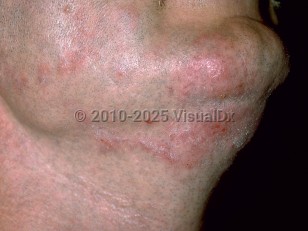Tinea barbae
Alerts and Notices
Important News & Links
Synopsis

Tinea barbae is also known as barber's itch. It is a localized inflammatory reaction to a dermatophyte occurring in the beard area of the face and neck. Species of Trichophyton are the most common causative organisms.
The lesions may be deep, kerion-like plaques or superficial patches resembling tinea corporis. The deeper, more inflammatory variants are due to infection with zoophilic species of dermatophyte, such as Trichophyton verrucosum or Microsporum canis acquired from animals such as cattle, horses, dogs, and cats. The more superficial forms are caused by anthropophilic species like Trichophyton rubrum. Involved hairs are often loose and easily removed with tweezers. Regional lymphadenopathy can occur if the infection has been long-standing or is superinfected.
Tinea barbae is more common in warm and humid climates. It has decreased in incidence since the advent of disposable razors. Permanent scarring and alopecia are possible sequelae.
Trichophyton mentagrophytes genotype type VII (TMVII) is an emerging strain that is typically spread through close contact, including sexual intercourse. It may lead to tinea of the genital, buttock, and/or beard area as well as tinea corporis.
The lesions may be deep, kerion-like plaques or superficial patches resembling tinea corporis. The deeper, more inflammatory variants are due to infection with zoophilic species of dermatophyte, such as Trichophyton verrucosum or Microsporum canis acquired from animals such as cattle, horses, dogs, and cats. The more superficial forms are caused by anthropophilic species like Trichophyton rubrum. Involved hairs are often loose and easily removed with tweezers. Regional lymphadenopathy can occur if the infection has been long-standing or is superinfected.
Tinea barbae is more common in warm and humid climates. It has decreased in incidence since the advent of disposable razors. Permanent scarring and alopecia are possible sequelae.
Trichophyton mentagrophytes genotype type VII (TMVII) is an emerging strain that is typically spread through close contact, including sexual intercourse. It may lead to tinea of the genital, buttock, and/or beard area as well as tinea corporis.
Codes
ICD10CM:
B35.0 – Tinea barbae and tinea capitis
SNOMEDCT:
399329002 – Tinea barbae
B35.0 – Tinea barbae and tinea capitis
SNOMEDCT:
399329002 – Tinea barbae
Look For
Subscription Required
Diagnostic Pearls
Subscription Required
Differential Diagnosis & Pitfalls

To perform a comparison, select diagnoses from the classic differential
Subscription Required
Best Tests
Subscription Required
Management Pearls
Subscription Required
Therapy
Subscription Required
References
Subscription Required
Last Reviewed:10/19/2020
Last Updated:12/07/2024
Last Updated:12/07/2024
 Patient Information for Tinea barbae
Patient Information for Tinea barbae
Premium Feature
VisualDx Patient Handouts
Available in the Elite package
- Improve treatment compliance
- Reduce after-hours questions
- Increase patient engagement and satisfaction
- Written in clear, easy-to-understand language. No confusing jargon.
- Available in English and Spanish
- Print out or email directly to your patient
Upgrade Today

Tinea barbae

